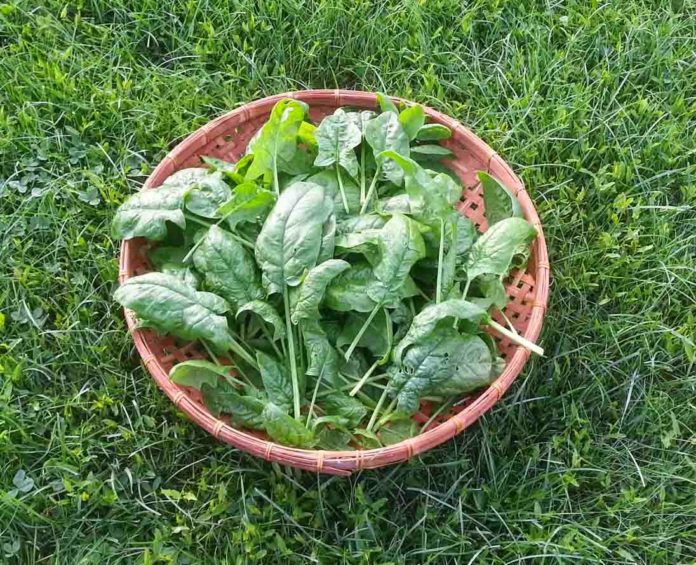Ever wondered when and how to harvest spinach in your garden? If yes, then this post is for you. Spinach is the 27th most popular vegetable in the world because of its hardy leafy green and full of Iron, Calcium, Vitamin A, B, and C and many other nutrients. With the famous cartoon ‘Popeye’, Spinach gained popularity among 90’s kids as a meal to gain instant energy and strength and thus helped mothers feed their children with this healthy vegetable easily.
With the increasing popularity of home delivery of essentials and vegetables, everything is now available at the doorstep, yet what can be better than having a fresh-grown vegetable garden in your backyard. How about turning your backyard into your own small fresh farm by growing and harvesting some spinach first. Let’s get started with all the information you might need to know when and how to harvest Spinach in your own little garden. Also, There are many varieties of Spanish like savoy Spanish, bloomsdale, tyee, regiment, Catalina, red carnival, New Zealand, Malabar Spanish, space spinach, Indian summer.
Spinach is a beautiful early spring popular crop with super cold and hardy leafy green.
Which belongs to the amaranth family and is related to beets and quinoa. Spinach is a vegetable full of antioxidants and multiple nutrients. Regular consumption of fresh Spinach reduces stress levels, prevents cancer and reduces blood pressure levels.
Read more- How To Grow Microgreens Without soil?
Nutrients present in Spinach
Nutritional Profile
Let’s see the types and amount of nutrients present in raw Spinach per 100gm
- Calories – 23
- Water – 91%
- Protein – 2.9 grams
- Carbs – 3.6 grams
- Sugar- 0.4 grams
- Fibre- 2.2 grams
- Fat- 0.4 grams
Vitamins present in Spinach
Vitamins are essential for the human body for its growth and immunity system. Fresh Raw Spinach has much more vitamins than many other vegetables.
- Vitamin A: Spinach has a high quantity of carotenoids, which turns into vitamin A for the human body.
- Vitamin C: Spinach has vitamin C in it; this vitamin promotes skin health and immune function.
- Vitamin K1: Spinach contains vitamin K1, which is essential for blood clotting.
- Vitamin B9: vitamin B9 is also known as folic acid. It is vital for pregnant women and for cellular.
Minerals present in Spinach
Spinach is a good source of minerals, some of which are:
- Iron: it helps in the creation of haemoglobin and the other oxygen tissues.
- Calcium: Calcium is essential for bone health, the nervous system, heart, and muscles.
- Zinc: Needed for the human immune system to function properly
- Phosphorus: needed for the formation of human teeth and bones
Spinach also contains small quantities of potassium, magnesium, and several other minerals.
plant compounds
Plant compounds are basically the compounds generated by plants that are healthy for the human body and help in the prevention or cure of many diseases. Some of the important plant compounds found in Spinach are:
- Lutein: Helps in improving eye health.
- Kaempferol: Decreases risk of cancer and chronic diseases
- Nitrates: Nitrates promote heart health.
- Quercetin: Quercetin helps to heal inflammation and infections.
- Zeaxanthin: Same as lutein, zeaxanthin also helps in improving eye health.
Read more- Grow A Beautiful Hibiscus Flower In Your Garden
Basic requirements to grow Spinach
Enough about the nutritional advantages of Spinach, let’s now move onto the requirements for growing Spinach:
- Drained and organic soil
- the pH of the soil should be 6.5 to 7
- Temperature for germination- 10°C – 22°C
- Sunlight
- The high amount of water
- Pesticides
How to grow Spinach?
Now that we know about all the requirements to grow Spinach, it’s time to grow this nutritional leafy green vegetable in your little garden space.
Here are the steps to solve all your confusions about how to grow Spinach:
- Gather the fresh spinach seeds and gardening tools
- Make sure that the area where you are going to harvest Spinach has proper light and shade.
- Check the pH of the soil; the Ph should be 6.5 to 7.
- Add composites to the soil.
- Sow the seeds half-inch deep in the soil.
- Only 3-4 seeds should be sowed in one place.
- During the germination process, make sure that the soil is moist.
- Provide at least 5-litre water to the plant.
- After the leaves appear, keep the plant away from sunlight.
- After 60 days, the plant will reach the mature stage and be ready to pick fresh Spinach.
For the better health of the crop, it is mandatory to follow all the above-mentioned steps carefully. After growing the Spinach, let’s move onto all the information you might need to know about when and how to pick your Spinach.
Read more- Aesthetic Plants That Will Give Your Home An Instant Personality
When to pick Spinach?
Spinach leaves reach their maturing stage within 40-45 days and sometimes 60 days, and so it is very important to harvest spinach leaves on time.
Few important precautions to follow while picking up Spinach:
- Only harvest the mature spinach leaves
- Use a sharp scissor
- Cut the base and the fresh leaves
- Do not pick the inner layer of Spinach
Health benefits of Spinach
Now when you know how to grow your own Spinach and when to harvest Spinach. Here is a list of a few of the benefits of including Spinach in your diet.
Fights Oxidative stress
In the human body, free radicals cause oxidative stress. Fresh Spinach contains antioxidants, which helps to fight with oxidative stress.
According to the experts’ research, eight people tried Spinach to cure oxidative stress, and it worked.
Improves Eye Vision
Spinach leaves contain high quantities of zeaxanthin and lutein, which are responsible for the colour of the vegetable.
Zeaxanthin and lutein help to increase eyesight.
Cancer prevention
Fresh Spinach leaves have two components named MGDG and SQDG.
These components slow down the growth of cancer and decrease the size of the brain tumour.
Blood pressure
Blood pressure and heart rate can be maintained by eating spinach leaves because it contains nitrates.
Nitrates also decrease heart diseases.
The adverse effect of Spinach
As we know, with great benefits come some side effects. Generally, Spinach works as a healthy vegetable, but in some cases, it might lead to some adverse effects like;
Kidney stone
The main causes of kidney stones are acid and mineral salt. The common variety of kidney stones are calcium stones.
Spinach leaves are rich in calcium and oxalates. So, the kidney stone patient should avoid eating Spinach.
Blood clotting
Vitamin K1, present in spinach leaves, helps in blood clotting. However, excess amounts of Vitamin K1 may lead to blood clotting when it is not even required. Thus, people with high Vitamin K1 in their bodies should avoid Spinach.
Read more- Benefits of Having Indoor Plants
Bottom Line
When taken in the right amount, Spinach can serve as the best vegetable for consumption by the human body. Due to its great nutritional value and low-calorie amount, Spinach is gaining more and more popularity among people who are on their weight loss journey. Along with that, Spinach is the most recommended vegetable by doctors to help the body prevent, cure or recover from many diseases.
Now, when you know when and how to harvest your own Spinach and its advantages, what are you waiting for? Create your own small garden area full of spinach and share pictures with us in the comment box.




